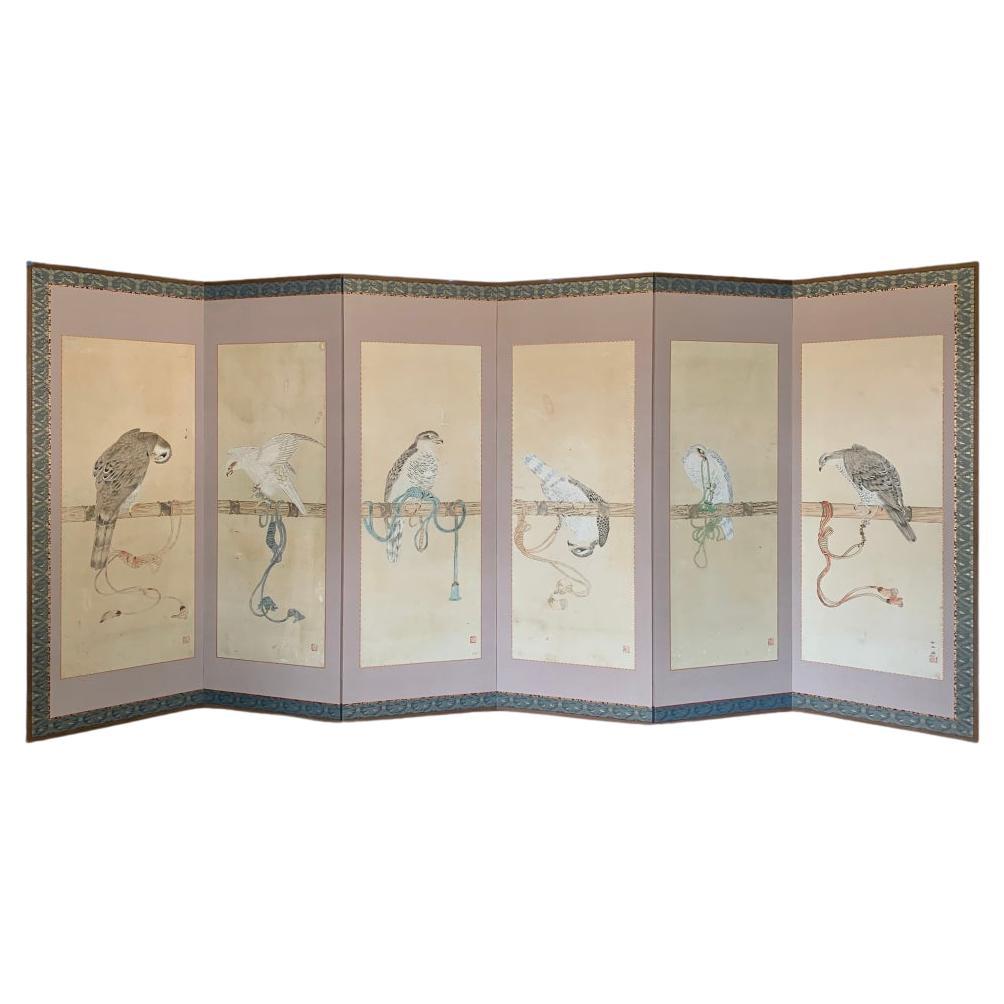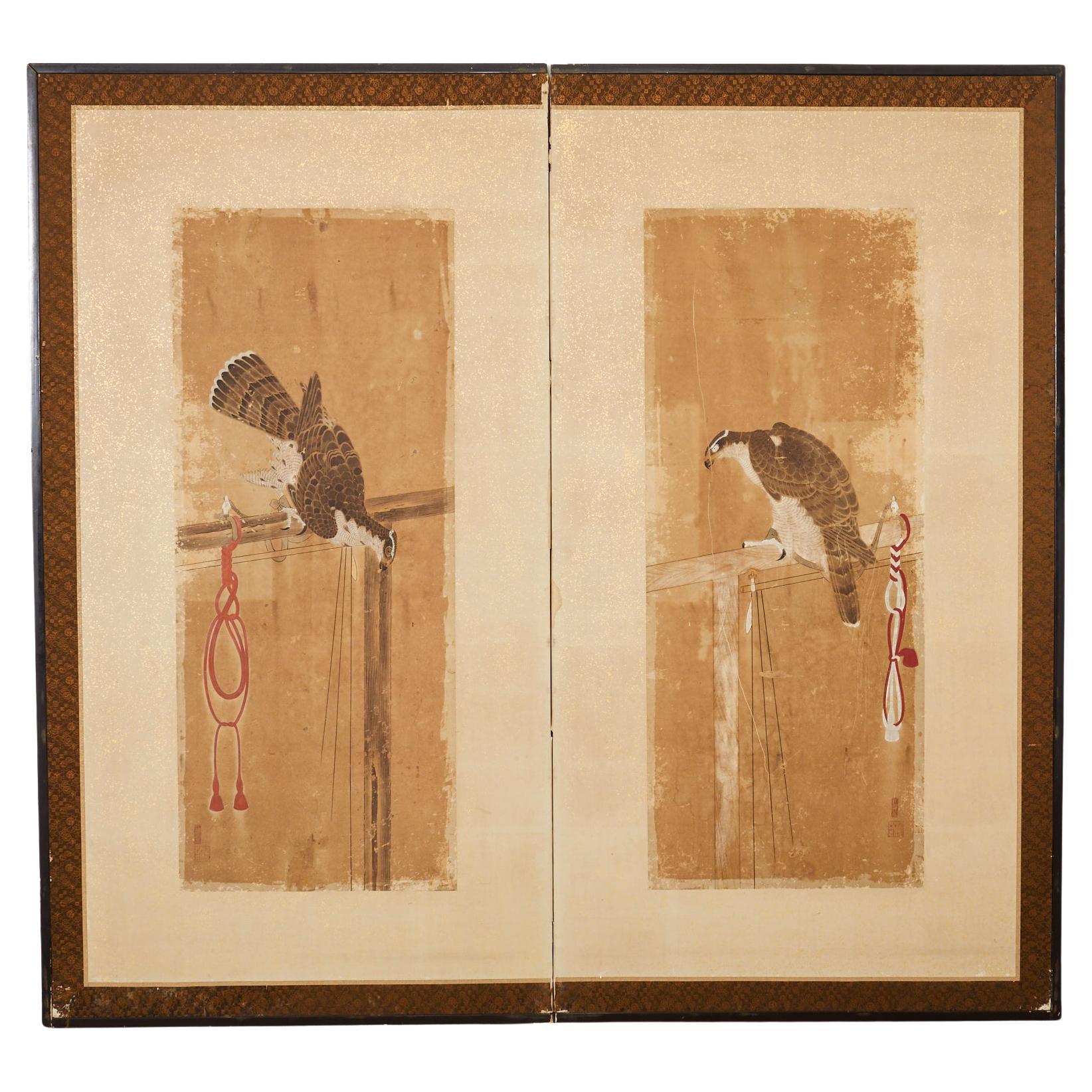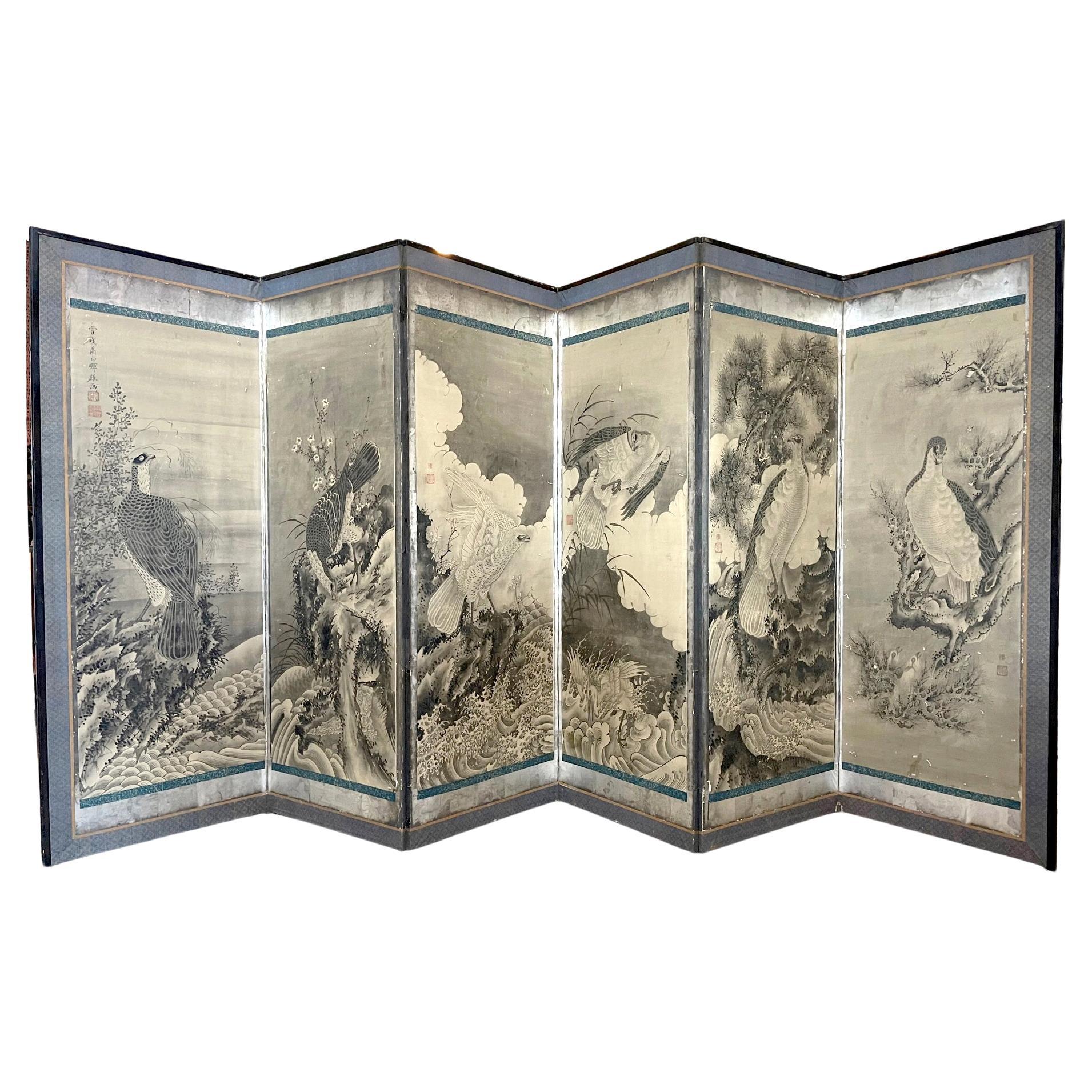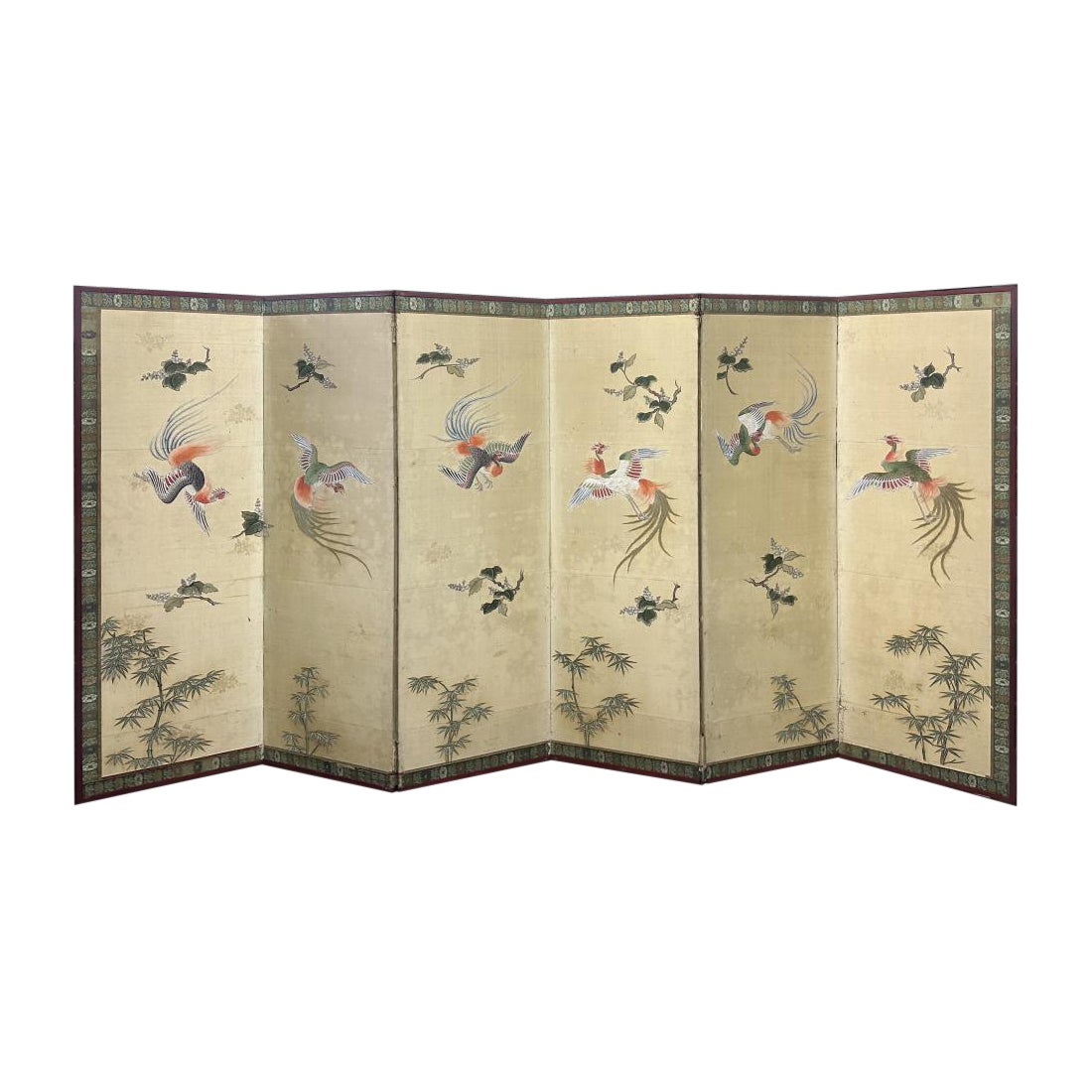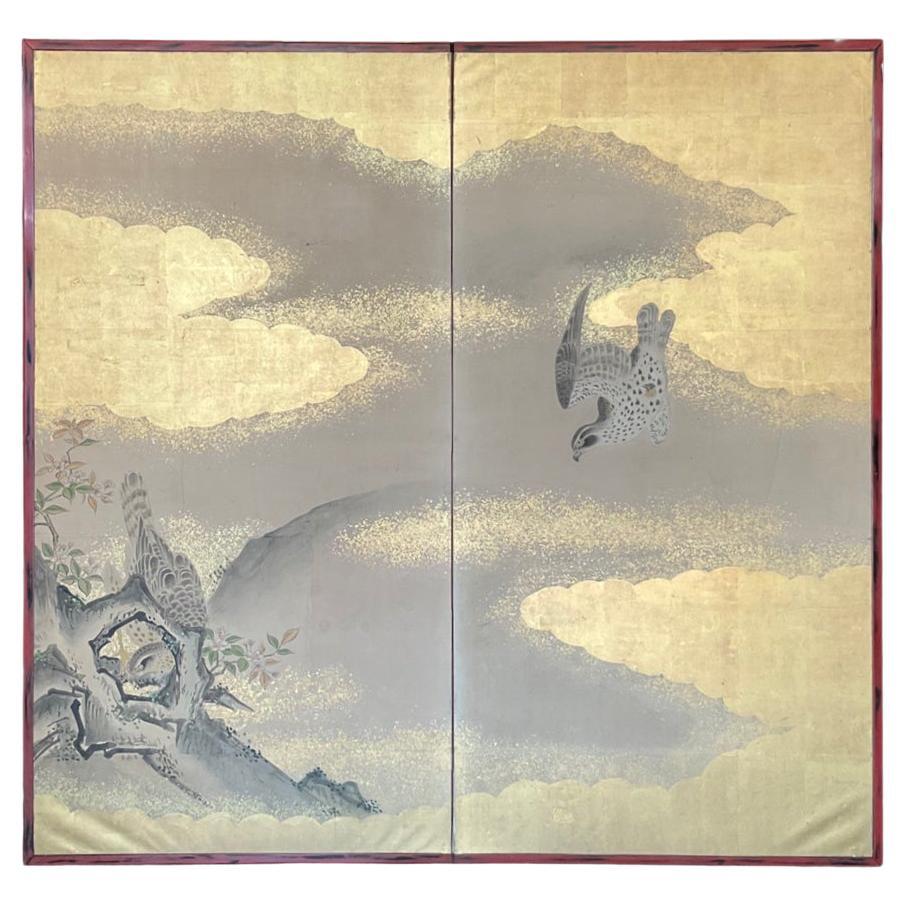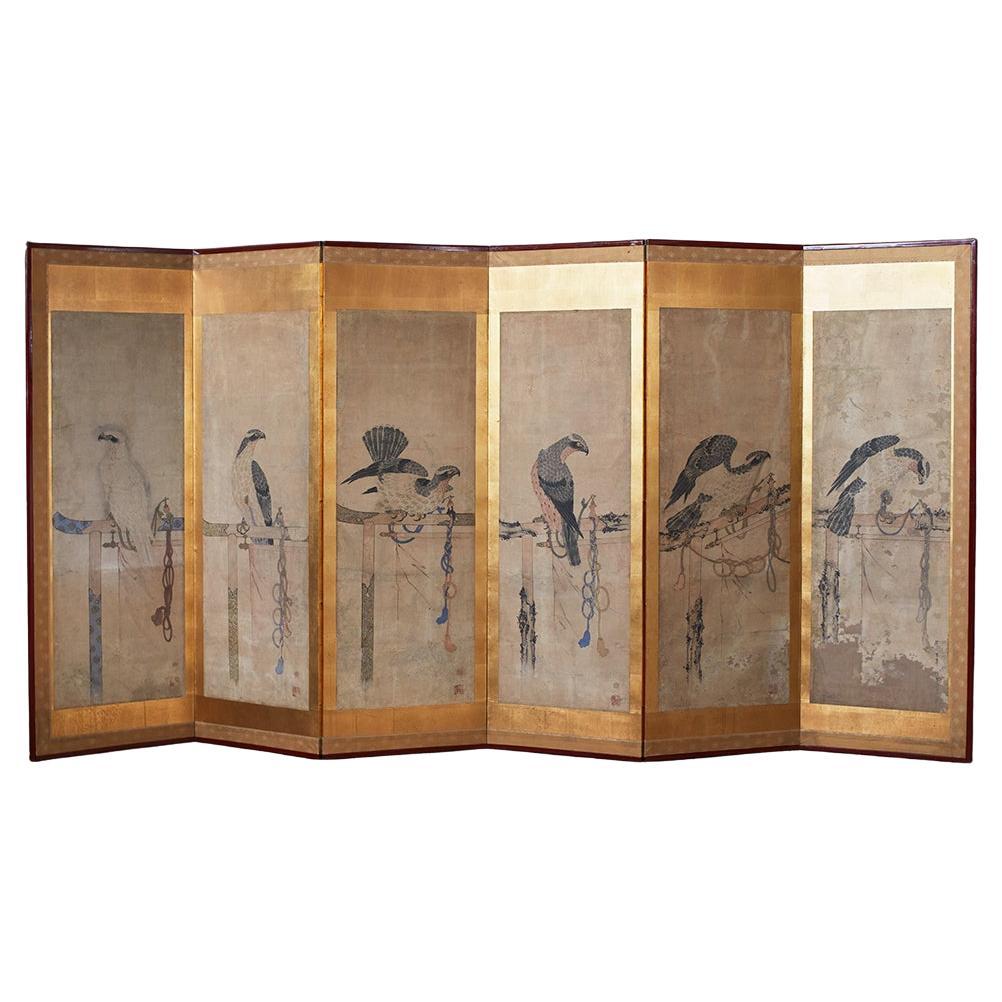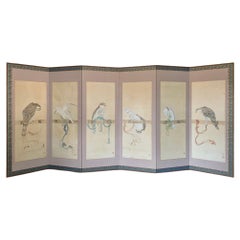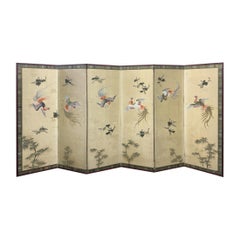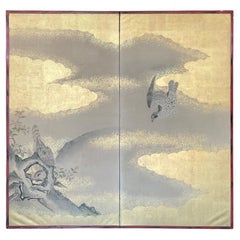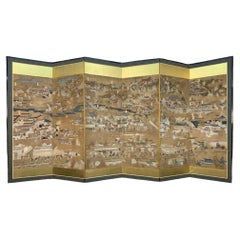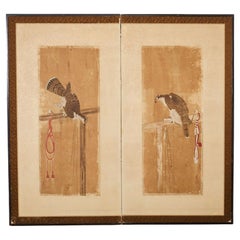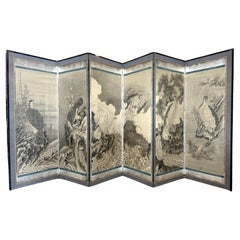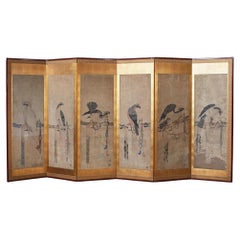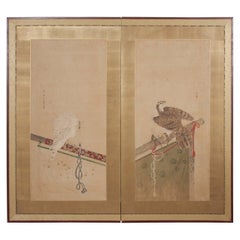Items Similar to Late 18th to Early 19th Century Hawk Screen
Want more images or videos?
Request additional images or videos from the seller
1 of 9
Late 18th to Early 19th Century Hawk Screen
$8,630
£6,555.19
€7,553.80
CA$12,153.18
A$13,473.59
CHF 7,080.90
MX$164,894.70
NOK 88,433.23
SEK 83,003.44
DKK 56,384.44
About the Item
Late 18th to Early 19th Century Hawk Screen
Period: Late Edo
Size: 372 x 125 cm (146.4 x 49.2 inches)
SKU: PTA63
Behold the grandeur of the late Edo period encapsulated in this magnificent Hawk screen. A period rich with cultural heritage and artistic depth, the Edo era brought to life scenes that echo Japan's vibrant history and the harmony of nature.
Stretching impressively across your view, this majestic screen transports you to a time where the symbolism of the hawk was revered, representing not just prowess and vigilance but also a celestial connection. Each panel depicts a narrative that unfolds under the watchful eyes of the magnificent hawk, a creature deeply ingrained in Japanese folklore and art.
Crafted meticulously during the transitional phase of the late 18th to early 19th century, this screen embodies the spirit of a Japan standing on the cusp of a new era. The detailed craftsmanship tells tales of expertise handed down through generations, coming alive in the form of this breathtaking piece.
To own this screen is to own a fragment of history, a window into the vibrant and profound narrative of Japanese culture. We invite you to DM us and explore more!
- Dimensions:Height: 49.22 in (125 cm)Width: 146.46 in (372 cm)Depth: 1.19 in (3 cm)
- Style:Edo (Of the Period)
- Materials and Techniques:
- Place of Origin:
- Period:
- Date of Manufacture:unknown
- Condition:Minor losses. Condition report upon request.
- Seller Location:Fukuoka, JP
- Reference Number:1stDibs: LU8121239097172
About the Seller
5.0
Vetted Professional Seller
Every seller passes strict standards for authenticity and reliability
Established in 1998
1stDibs seller since 2023
60 sales on 1stDibs
Typical response time: <1 hour
- ShippingRetrieving quote...Shipping from: Tambon Hang Dong, Thailand
- Return Policy
Authenticity Guarantee
In the unlikely event there’s an issue with an item’s authenticity, contact us within 1 year for a full refund. DetailsMoney-Back Guarantee
If your item is not as described, is damaged in transit, or does not arrive, contact us within 7 days for a full refund. Details24-Hour Cancellation
You have a 24-hour grace period in which to reconsider your purchase, with no questions asked.Vetted Professional Sellers
Our world-class sellers must adhere to strict standards for service and quality, maintaining the integrity of our listings.Price-Match Guarantee
If you find that a seller listed the same item for a lower price elsewhere, we’ll match it.Trusted Global Delivery
Our best-in-class carrier network provides specialized shipping options worldwide, including custom delivery.More From This Seller
View AllMid-Edo Hawk Screen
Located in Fukuoka, JP
Step into the world of Mid Edo Japan with our six-panel Hawk screen, each depicting a different hawk. In this period, hawks were revered not only for their majestic beauty but also f...
Category
Antique 18th Century Japanese Edo Paintings and Screens
Materials
Wood, Paper
$7,920
Edo-Meiji Phoenix Birds Screen
Located in Fukuoka, JP
Edo-Meiji Phoenix Birds Screen
Period: Edo-Meiji
Size: 360 x 152 cm (141.73 x 60 inches)
SKU: PD16
This gorgeous silk screen from the Edo-Meiji period showcases mythical phoenix bi...
Category
Antique 19th Century Japanese Edo Paintings and Screens
Materials
Silk, Paper
Majestic Hawks Edo Screen by Tosa School
Located in Fukuoka, JP
Majestic Hawks Edo Screen
Period: Edo
Size: 150x168 cm (59x66 inches)
SKU: PTA93
Step back in time to the Edo period with our superb Tosa school screen d...
Category
Antique 19th Century Edo Paintings and Screens
Materials
Gold Leaf
Edo Period Kyoto Screen (2/2)
Located in Fukuoka, JP
Edo Period Kyoto Screen
Period: Edo period
Size: 343 x 176 cm (134.6 x 69 inches)
SKU: RJ69/2
This stunning Edo period screen depicts typical scenes of...
Category
Antique 18th Century Japanese Edo Paintings and Screens
Materials
Silk, Wood, Paper
Edo Period Kyoto Screen
Located in Fukuoka, JP
Edo Period Kyoto Screen
Period: Edo period
Size: 343 x 176 cm (134.6 x 69 inches)
SKU: RJ69
This stunning Edo period screen depicts typical scenes of d...
Category
Antique 18th Century Japanese Edo Paintings and Screens
Materials
Silk, Wood, Paper
Early Edo Period Chinese-Inspired Screen
Located in Fukuoka, JP
This remarkable screen from the early Edo period, circa the 17th century, showcases the influence of early Chinese art forms with its intricate ink work on a gold leafed surface. The...
Category
Antique 17th Century Japanese Edo Paintings and Screens
Materials
Gold Leaf
You May Also Like
Japanese Edo Two Panel Screen Birds of Prey Hawks
Located in Rio Vista, CA
Fascinating Japanese 19th century Edo period two-panel screen depicting two perched birds of prey. Painted in the manner of Chokuan Soga (17th century). Large size byobu screen with ...
Category
Antique 19th Century Japanese Edo Paintings and Screens
Materials
Silk, Wood, Paper
Rare Japanese Floor Screen of Perched Eagles Soga Shohaku Edo period
Located in Atlanta, GA
A rare six-panel Japanese folding floor screen (Byōbu) by Soga Shōhaku (1730-1781) from Edo period. The screen depicts six perched hawk-eagles in various poses positioned in a litera...
Category
Antique 18th Century Japanese Edo Paintings and Screens
Materials
Brocade, Wood, Paper
A Single Late 19th Century Six Panel Paper Screen, in the manner of Soga Chokuan
Located in London, GB
Six gouache painted scenes of tethered hawks, laid down to form a six panel screen, with pigment and ink on rice paper, surrounded by thickly set gold leaf border, and Japanese silk ...
Category
Antique 19th Century Japanese Edo Paintings and Screens
Materials
Gold Leaf
Japanese Edo Period Two-Panel Screen
Located in Stamford, CT
A Japanese Edo Period two panel folding screen with white and brown hawks of ink and color on paper.
Category
Antique Mid-19th Century Japanese Edo Paintings and Screens
Materials
Paper
Japanese Edo Period Festival Screen, c. 1750
Located in Chicago, IL
This 18th century folding screen is a stunning example of Japanese artistry. Beautifully painted with delicate brushwork, the evocative sc...
Category
Antique Mid-18th Century Japanese Edo Paintings and Screens
Materials
Paper
Rare Antique Japanese Folding Screen by Kano Tanshin
By Kano Tanshin
Located in Atlanta, GA
An exquisite Japanese folding screen painted and signed by Kano Tanshin (Morimasa) (1658-1719), circa early Edo Period. An important member of the Kano painter family, the son of Kano Tanyu...
Category
Antique 17th Century Japanese Japonisme Paintings and Screens
Materials
Brass
More Ways To Browse
18th And 19th Century Paintings
18th Century Hand Screen
18th Century Japanese Screens
Antique Window Screens
Asian Window Screens
Antique Hawk Painting
Japanese Screen Hawk
Japanese Folding Screens
Chinese Bird Painting
Japanese Gold Leaf Panel Paintings
Japanese Painting Silk Gold
4 Panel Chinese
Vintage Asian Art Panels
Gold Folding Screen
Japanese Art Of Cranes
Qing Dynasty Painting
Red Chinese Screen
Chinese Screens Carved Wood
